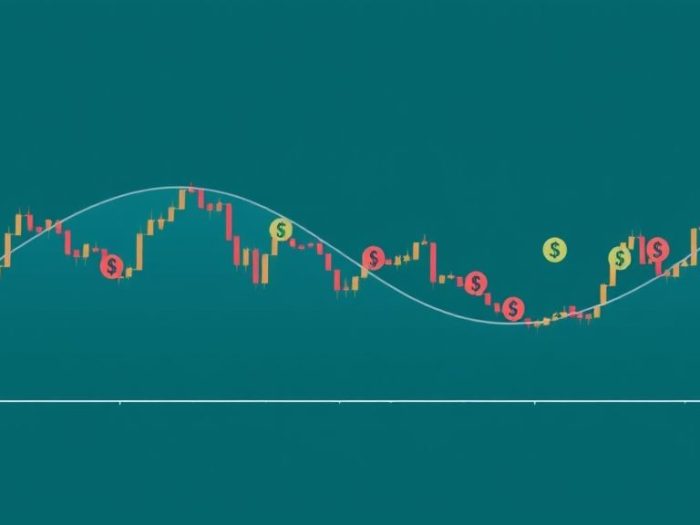Swing trading is a popular trading style that aims to profit from price swings within a
larger trend. While no strategy can guarantee a 70%+ win rate consistently in the
volatile forex market, this article outlines a simple and relatively high-probability
swing trading strategy suitable for beginners. It emphasizes using key indicators and
risk management to improve your chances of success.
Understanding Swing Trading
Swing trading involves holding positions for several days to weeks, aiming to capture
profits from price movements within a trend. It contrasts with day trading (holding
positions for minutes or hours) and position trading (holding positions for months or
years).
Key Components of the Strategy
- Currency Pair: Focus on major currency pairs (e.g., EUR/USD, GBP/USD) for high liquidity and lower spreads.
- Timeframe: Use the daily chart for identifying the overall trend and 4-hour chart for precise entries.
-
Indicators:
- 200-period Moving Average (200 MA): To determine the long-term trend.
- Relative Strength Index (RSI): To identify overbought and oversold conditions.
- Risk Management: Use stop-loss orders and manage position size to protect your capital.
The Strategy: Trend Following with RSI Confirmation
1. Identify the Long-Term Trend (Daily Chart)
- Uptrend: Price is consistently above the 200 MA. Look for long (buy) opportunities.
- Downtrend: Price is consistently below the 200 MA. Look for short (sell) opportunities.
- Sideways: Price is oscillating around the 200 MA. Avoid trading or use a different strategy.
2. Pinpoint Entry Points (4-Hour Chart)
Once you’ve identified the trend on the daily chart, use the 4-hour chart to find precise entry points.
-
Long Entry (Uptrend):
- Wait for the price to retrace (pull back) after an upward move.
- Enter a long position when the price bounces off a support level and the RSI is oversold (below 30).
-
Short Entry (Downtrend):
- Wait for the price to rally (move up) after a downward move.
- Enter a short position when the price bounces off a resistance level and the RSI is overbought (above 70).
3. Set Stop-Loss and Take-Profit Levels
- Stop-Loss: Place your stop-loss order below the support level for long positions or above the resistance level for short positions. This limits your potential loss.
- Take-Profit: Set your take-profit level at a reasonable distance, aiming for a risk-to-reward ratio of at least 1:2 (e.g., risk $50 to make $100).
Example
EUR/USD:
- Daily chart shows an uptrend (price above 200 MA).
- On the 4-hour chart, the price retraces to a support level and the RSI is below 30.
- Enter a long position.
- Place a stop-loss order below the support level.
- Set a take-profit order at a level that provides a 1:2 risk-to-reward ratio.
Important Considerations
- Backtesting: Test this strategy on historical data using a demo account to understand its performance.
- Market Conditions: This strategy may be less effective during periods of high volatility or sideways market movement.
- News Events: Be aware of upcoming news events that could impact the currency pair.
- Patience: Wait for the precise entry conditions to be met. Don’t chase trades.
- Risk Management: Never risk more than 1-2% of your trading capital on a single trade.
Disclaimer
Forex trading involves significant risk, and no strategy can guarantee profits. While
this strategy aims to increase your chances of success, it’s essential to understand
that losses are possible. This information is for educational purposes only and not
financial advice.
Conclusion
This simple swing trading strategy using trend following and RSI confirmation can be a
useful tool for beginners. However, remember that forex trading is complex and
requires continuous learning and adaptation. Always practice risk management and trade
responsibly.
Related Keywords
Forex swing trading strategy, simple forex strategy, forex strategy for beginners,
high win rate forex strategy, forex trading indicators, forex trading signals, forex
trading system, forex trading plan, best forex strategy, forex trading tutorial.
Frequently Asked Questions (FAQ)
1. What is swing trading?
Swing trading involves holding positions for several days to weeks to profit from price swings within a trend.
2. What are major currency pairs?
Major currency pairs include the US dollar (USD) and other major currencies like EUR, JPY, GBP, CHF, CAD, and AUD.
3. Why are major pairs recommended for beginners?
Major pairs are highly liquid, generally less volatile, and have tighter spreads, making them more beginner-friendly.
4. What timeframe should I use for this strategy?
Use the daily chart to identify the long-term trend and the 4-hour chart for precise entry points.
5. What is the 200-period Moving Average (200 MA) used for?
The 200 MA is used to determine the long-term trend. Price above the 200 MA indicates an uptrend, while price below indicates a downtrend.
6. What does the Relative Strength Index (RSI) measure?
RSI measures the magnitude of recent price changes to evaluate overbought (above 70) and oversold (below 30) conditions.
7. How do I identify entry points in an uptrend?
In an uptrend, wait for the price to retrace and enter a long position when the price bounces off a support level and the RSI is oversold.
8. How do I identify entry points in a downtrend?
In a downtrend, wait for the price to rally and enter a short position when the price bounces off a resistance level and the RSI is overbought.
9. Where should I place my stop-loss and take-profit orders?
Place your stop-loss order below the support level for long positions and above the resistance level for short positions. Set your take-profit level at a level that provides a 1:2 risk-to-reward ratio.
10. Is this strategy a guarantee of profits?
No, forex trading involves significant risk, and no strategy can guarantee profits. This strategy aims to increase your chances of success, but losses are possible.



